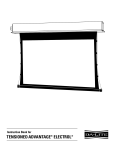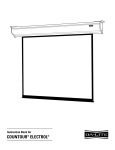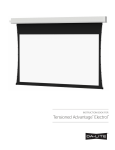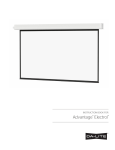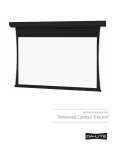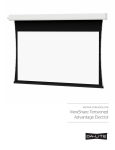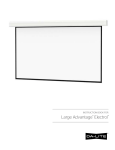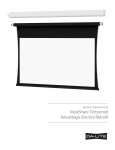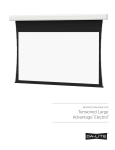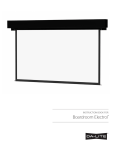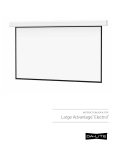Download Da-Lite Tensioned Advantage Electrol
Transcript
Instruction Book for TENSIONED ADVANTAGE® ELECTROL® IMPORTANT SAFETY INSTRUCTIONS When using your video equipment, basic safety precautions should always be followed, including the following: 1.Read and understand all instructions before using. 2.Position the cord so that it will not be tripped over, pulled, or contact hot surfaces. 3. If an extension cord is necessary, a cord with a current rating at least equal to that of the appliance should be used. Cords rated for less amperage than the appliance may overheat. 4. To reduce the risk of electric shock, do not disassemble this appliance. Contact an authorized service dealer when repair work is required. Incorrect reassembly can cause electric shock when the appliance is used subsequently. 5. The use of an accessory attachment not recommended by the manufacturer may cause a risk of fire, electric shock, or injury to persons. TOOLS REQUIRED FOR INSTALLATION #2 Phillips Screwdriver 1/2“ Open Wrench or Socket Driver 1/8” Hex Key (included) PRE-INSTALLATION 1. Carefully unpack case from shipping carton. 2. Set aside the Installation Kit. Items inside will be used during installation. 3. Make sure to recheck measurement of case for proper installation clearance. 4. Remove any protective foam covering the outside of the case. 5. For shipping purposes, foam is also inserted between the roller brackets and endcaps (Figure 1). Remove these foam blocks from the ends. 6. Remove the hanger brackets from the top of the case using a 1/2” wrench. Do not discard the hardware; it will be used during case installation to re-attach the hanger brackets for mounting. CASE INSTALLATION 1. Hang case and attach to support structure with bolts. See Suggested Methods of Installation. 2. Tighten bolts until trim flange is flush with ceiling. NOTE: For proper operation, screen assembly must be level after installation. 3. Remove 2 screws to open junction box. Install electrical connections that apply to your unit. Make sure to review the wiring diagram for proper hook up. Replace junction box cover and secure with 2 screws. 2 NOTE: Must be installed in accordance with the requirements of the Local Building Codes, the Canadian Electrical Code (CEC), CAN/CSA C22.1 and the National Electric Code (NEC), NFPA 70. If your case was ordered in advance of the screen and roller assembly, your installation is now complete. Continue to step 4 if your Tensioned Advantage Electrol was ordered as a complete unit. 4. Use supplied 1/8" hex key and #2 phillips screwdriver to remove silver shipping brackets attached to slat and screen case. 5. Test installation by running screen up and down a few times. Be prepared to stop screen should any objects obstruct the movement of the screen. To prevent damage to the motor, the standard duty cycle is 1 minute on and 3 minutes off. SCREEN AND ROLLER ASSEMBLY INSTALLATION Follow these steps if your screen and roller assembly was ordered separately from the case. 1. Remove the access door. First, remove the 2 screws from the ends. Be sure to support the door during this step to avoid injury. Then lift the door slightly and pull away from the edge of the case (Figure 1). 2. Carefully unpack screen and roller assembly. Remove fabric and roller assembly from shipping board. Leave packing paper on roller. 3. To install screen and roller assembly, loosen (but do not remove) four 1/4-20 nuts securing pin end bracket (opposite end from the junction box) to the case housing. Slide the pin end bracket towards the end of the case (Figure 2). 6. Complete electrical hook-up by snapping motor wire connector into case connector (Figure 3). 8. Test installation by running screen up and down a few times. Be prepared to stop screen should any objects obstruct the movement of the screen. To prevent damage to the motor, the standard duty cycle is 1 minute on and 3 minutes off. 9. Re-install the access door. Procedure is the reverse of step 1 listed above. 4. Insert the motor end square shaft into the motor end bracket (junction box end) and secure with the clip (Figure 3). 5. Moving to the pin end of the case, slide the pin end bracket until the hole fits securely over the pin. Tighten the 1/4-20 nuts on the pin end bracket securely (Figure 2). Clip 1/4-20 Nuts Motor Power Connector Motor Access Door Screws Foam Blocks Motor Mount Bracket Figure 1 Figure 2 Figure 3 3 TENSIONED ADVANTAGE® ELECTROL® SUGGESTED METHODS OF INSTALLATION METHOD 1 6-1/16" 6-7/16" 7-3/4" Variable Position Mounting Bracket 8" Audience Side Motor End 6-1/16" 3/8" Threaded Rod (Not Included) Attached To Mounting Bracket Electrical Junction Box 6-3/8" Self-Trimming Flange Finished Ceiling 7-3/4" METHOD 2 3/8" Threaded Rod (Not Supplied) Hanger Bracket 3-7/16" 7-7/16" 6-7/16" 7-3/4" 4 SCREEN ADJUSTMENT FOR 120V SCREENS If your Tensioned Advantage Electrol was ordered as a complete unit, the up and down limits were pre-set by Da-Lite. If your screen and roller assembly was ordered separately from the case, or if general adjustment is needed, please follow the steps below and refer to the 120V Wiring Diagram 1. Locate the wall switch and remove the cover plate from the wall switch and remove the switch from the junction box. 2. Locate the two tactile buttons on the back of the switch. They are black round buttons on silver plates. See 120V Wiring Diagram. 3. To adjust the down limit switch, press and hold the down tactile button until the LED on the back of the switch turns solid red. This will put the motor in limit set mode. Turn the wall switch over and use the down button on the front of the switch. Press and hold the down button until the desired down position is reached. If you travel too far down, press the up button to move the screen upward. If you press and let go of either the up or down buttons, the motor will do a small jog in that direction for fine adjustment of the screen. Once the desired position is reached, turn the switch over; press and hold the down tactile button until the LED on back of switch blinks red twice. The down limit is now set. CAUTION: DO NOT ADJUST FOR MORE DROP THAN WHAT WAS ORDERED. AT LEAST 1–1/2 WRAPS OF FABRIC MUST REMAIN ON THE ROLLER. THIS SCREEN COMES STANDARD WITH 12" BLACK AT THE TOP. NOTE: If the screen is in limit set mode and no buttons are pushed for 20 seconds, the LED on the back of the wall switch will turn off, the motor will return to run mode and no changes will be saved. If this occurs, return to step 3 for down limit adjustment or step 4 for up limit adjustment. 4. To adjust the up limit switch, press and hold the up tactile button until the LED on the back of the switch turns solid green. This will put the motor in limit set mode. Turn the wall switch over and use the up button on the front of the switch. Press and hold the up button until the desired up position is reached. If you travel too far up, press the down button to move the screen downward. If you press and let go of either the up or down buttons, the motor will do a small jog in that direction for fine adjustment of the screen. Once the desired position is reached, turn the switch over; press and hold the up tactile button until the LED on back of switch blinks green twice. The up limit is now set. CAUTION: ADJUSTING THE UP LIMIT SWITCH BY MORE THAN 6” CAN CAUSE THE SCREEN SURFACE TO LOSE PROPER TENSIONING. 5. To test the limit switch settings, press and release the up or down buttons on the switch to operate the screen. 6. Replace the switch and cover plate on the wall. IMPORTANT NOTE: The wall switch is REQUIRED to make any limit switch adjustments, even if a third party control system is used. Therefore, it is advised to wire the switch or provide a 3-conductor connection that is accessible. CAUTION: ADJUSTING THE UP LIMIT SWITCH BY MORE THAN 6” CAN CAUSE THE SCREEN SURFACE TO LOSE PROPER TENSIONING. SCREEN ADJUSTMENT FOR 220V/240V SCREENS 1. Remove the cover plate from the 3-button wall switch and remove the switch from the junction box. 2. Locate small 3-position switch on back of wall switch. See Figure 5 for 120V screens or Figure 8 for 220/240V screens. 3. To adjust the down limit switch, slide the 3-position switch to the down position. Press and hold the down button to run the screen down to the desired stop position. Release the button to stop the screen. DO NOT PUSH THE STOP BUTTON. CAUTION: DO NOT ADJUST FOR MORE DROP THAN WHAT WAS ORDERED. AT LEAST 1–1/2 WRAPS OF FABRIC MUST REMAIN ON THE ROLLER. THIS SCREEN COMES STANDARD WITH 12" BLACK AT THE TOP. SEE THE SPECIFICATION DATA SHEET FOR DETAILS. 4. When the screen is in the desired down position, slide the 3-position switch to the off (center) position. The down limit switch is now set. 5. To adjust the up limit switch, slide the 3-position switch to the up position. Press and hold the up button to run the screen up to the desired stop position. Release the button to stop the screen. DO NOT PUSH THE STOP BUTTON. 6. When the screen is in the desired up position, slide the 3-position switch to the off (center) position. The up limit switch is now set. 7. To test limit switch setting, make sure the 3-position switch is in the off (center) position. Press and release the up or down button on the wall switch to operate the screen. 8. Replace switch and cover plate on the wall. NOTE: If stop button is pressed, the wall switch will reverse direction. To correct this, press the stop button again. This will reset the switch. You will have to re-set both the up and the down limit settings. IMPORTANT NOTE: The wall switch is REQUIRED to make any limit switch adjustments, EVEN if a third party control system is used. Therefore, it is advised to wire the switch or provide a 4-conductor connection that is accessible. 5 TENSIONED ADVANTAGE® ELECTROL® INSTALLATION FOR 120V SCREENS 120V WIRING DIAGRAM UP 3-conductor 20–24 gauge wire can be used in place of the supplied RJ-14 cable to connect the wall switch. Connect the BUS terminals on the wall switch to the corresponding BUS terminals on the splitter board. STO P DO WN IMPORTANT NOTE: The wall switch is REQUIRED to make any limit switch adjustments, EVEN if a third party control system is used. Therefore, it is advised to wire the switch or provide a 3-conductor connection that is accessible. LED Up Limit Tactile Button Up (Dry Contact) Down (Dry Contact) Common (Both) Bus (Bus) 5V (Bus) RJ-22 Output RJ-22 Inputs UP STOP DOW N UP P 5V COM BUS STO Bus Down Limit Tactile Button DO WN Front of Wall Switch Back of Wall Switch RJ-22 Jack RJ-45 Receptacle 5V COM BUS RJ-22 Jack (Connection to Wall Switch) 5V COM BUS RJ-45 Jack Data Cable Installation Video To view a video of this installation, visit http://youtu.be/t2ZQ9PVAhEg or use the QR code below. Power Wire White (Common) Black (Hot) Green (Ground) (Ground–Must be Connected to Building Ground) Power Input 120VAC / 60Hz RJ-14 Pin-Outs (Tab Is Facing Up) RJ-22 Pin-Outs (Tab Is Facing Up) +12V White Bus (RP Data) Yellow RQ Data Green RQ Data Green +5V Ground Red Black Supplied RJ-14 cable 6 Blue Bus (RP Data) +5V Red Ground Black RQ Clock White Standard RJ-22 can be used in place of RJ-14 cable RJ-45 Pin-Outs (Tab Is Facing Up) Manual 2 +12V Bus (RP Data) RQ Data +5V Ground RQ Clock Manual 1 Brown Blue Yellow Green Red Black Orange Purple TENSIONED ADVANTAGE® ELECTROL® INSTALLATION FOR 120V SCREENS 120V WIRING DIAGRAM WITH OPTIONAL BUILT-IN VIDEO PROJECTOR INTERFACE CAUTION: The projector must be turned off before connecting the trigger wires to the projector. Failure to do so may damage the controller. IMPORTANT NOTE: The wall switch is REQUIRED to make any limit switch adjustments, EVEN if a third party control system is used. Therefore, it is advised to wire the switch or provide a 3-conductor connection that is accessible. Use 2-conductor 20–24 gauge wire to extend the low voltage connection from the projector’s 5 or 12-volt screen trigger output to the length required to reach the VPI. When extending the low voltage connection from the projector’s screen trigger output polarity does not matter. The red and black wires from the VPI are interchangeable. 3-conductor 20–24 gauge wire can be used in place of the supplied RJ-14 cable to connect the wall switch. Connect the BUS terminals on the wall switch to the corresponding BUS terminals on the splitter board. UP STO P DO WN LED Up Limit Tactile Button Up (Dry Contact) Down (Dry Contact) Common (Both) Bus (Bus) 5V (Bus) RJ-22 Output RJ-22 Inputs UP STOP DOW N UP P 5V COM BUS STO Bus Down Limit Tactile Button DO WN Front of Wall Switch Back of Wall Switch RJ-22 Jack RJ-45 Receptacle 5V COM BUS RJ-22 Jack (Connection to Wall Switch) 5V COM BUS VPI Trigger Module RJ-45 Jack Data Cable Power Wire Black Red White (Common) Black (Hot) Green (Ground) (Ground–Must be Connected to Building Ground) Power Input 120VAC / 60Hz 5/12 Volt Screen Trigger on Projector 7 TENSIONED ADVANTAGE® ELECTROL® INSTALLATION FOR 220/240V SCREENS 240V WIRING DIAGRAM ILT RJ-9 Pin-Outs (Tab Is Facing Up) IMPORTANT NOTE: The wall switch is REQUIRED to make any limit switch adjustments, EVEN if a third party control system is used. Therefore, it is advised to wire the switch or provide a 4-conductor connection that is accessible. IR or Up Black Ground Common Red +5V Green Data or Down White Blue (Common) Power Input 240VAC / 50Hz Brown (Hot) Motor RJ9 RJ9 UP UP DN Green GND +5V STOP Green Ground to Case UP +5V COM DN NOTE: Ground–Must be Connected to Building Ground 3-POSITION SWITCH RJ9 DOWN Splitter Dry Contacts Front of Wall Switch Back of Wall Switch 240V WIRING DIAGRAM WITH OPTIONAL BUILT-IN VIDEO PROJECTOR INTERFACE CAUTION: THE PROJECTOR MUST BE TURNED OFF BEFORE CONNECTING THE TRIGGER WIRES TO THE PROJECTOR. FAILURE TO DO SO MAY DAMAGE THE CONTROLLER. 1. Use 2-conductor 20-24 gauge wire to extend the low voltage connection from the projector’s 5 or 12-volt screen trigger output to the length required to reach the VPI. When extending the low voltage connection from the projector’s screen trigger output, be sure to maintain the proper polarity. The red wire from the VPI is the “signal” and the black wire from the VPI is the “ground”. 2. Connect the wires from the VPI that are labeled “Low Voltage Connection” to the end of the extended screen trigger wires above. IMPORTANT NOTE: The wall switch is REQUIRED to make any limit switch adjustments, EVEN if a third party control system is used. Therefore, it is advised to wire the switch or provide a 4-conductor connection that is accessible. Brown (Hot) 240VAC/ 50Hz Power Source Green/Yellow (Ground) Green/Yellow (Ground) Brown (Down) Blue (Common) Black (Up) Blue (Common) White Red Front of Wall Switch Back of Wall Switch Black Black Red 8 5/12 Volt Screen Trigger on Projector TROUBLESHOOTING Visit www.da-lite.com/products/tutorials.php to find installation and troubleshooting tutorials. You will also find a link to Live Chat for interactive support. Symptom You can contact us by email at [email protected] or by phone at 800.622.3737 or 574.267.8101 with any additional troubleshooting questions. Cause Solution Incorrect line voltage. Verify 115-125V (or 220-240V). If insufficient voltage, rewire incoming electric line. Blown fuse. Replace fuse. Tripped circuit breaker. Reset circuit breaker. creen will not operate S and motor does not hum. No power to operating switch or junction. Check above. Tighten all loose wire connections. Correct any improper connections. Down Position Check for power across black and white leads. Up Position Check for power across red and white leads. Screen will not operate and motor does not hum. Power at junction box. Screen does not stop at correct position. Noise. OTE: Screen will operate N with a low pitched hum. Coasting. Fabric hangs crooked. Thermal overload tripped. Let motor cool down for 15 minutes. Try again. Broken wire in the “down” or “up” position. Check for continuity. Cut off old splice and reconnect. Defective motor, limit switch or capacitor. Replace motor assembly. NOTE: Motor is a sealed assembly. Capacitor burned out. Replace motor assembly. Limit switch out of adjustment. See Screen Adjustment section. queaking, rubber end plug rubbing on S motor. Center roller in case. rinding. Foreign object in screen G rubbing on roller or fabric. Remove. Gear noise. Replace motor assembly. Defective brake. Replace motor assembly. Screen not installed properly. Check for level and plumb. Fabric has backed up inside case. djust “down” limit switch slowly until roller is A exposed and wrinkle comes out, then readjust for proper drop. Fabric is damaged. Replace fabric. 9 10 11 LIMITED FIVE YEAR WARRANTY ON DA-LITE TENSIONED ADVANTAGE® ELECTROL® PRODUCTS ONLY Da-Lite Screen Company LLC warrants these products to the original purchaser only, to be free from defects in materials and workmanship for a period of five (5) years from the date of purchase by the original purchaser provided they are properly operated according to Da-Lite’s instructions and are not damaged due to improper handling or treatment after shipment from the factory. This warranty does not apply to equipment showing evidence of misuse, abuse or accidental damage, or which has been tampered with or repaired by a person other than authorized Da‑Lite personnel. Da-Lite’s sole obligation under this warranty shall be to repair or to replace (at Da-Lite’s option) the defective part of the merchandise. Returns for service should be made to your Da-Lite dealer. If it is necessary for the dealer to return the screen or part to Da-Lite, transportation expenses to and from Da-Lite are payable by the purchaser and Da-Lite is not responsible for damage in shipment. To protect yourself against damage or loss in transit, insure the product and prepay all transportation expenses. THIS WARRANTY IS IN LIEU OF ALL OTHER WARRANTIES, EXPRESS OR IMPLIED, INCLUDING WARRANTIES AS TO FITNESS FOR USE AND MERCHANT ABILITY. Any implied warranties of fitness for use, or merchantability, that may be mandated by statute or rule of law are limited to the five (5) year warranty period. This warranty gives you specific legal rights, and you may also have other rights, which vary from state-to-state. NO LIABILITY IS ASSUMED FOR EXPENSES OR DAMAGES RESULTING FROM INTERRUPTION IN OPERATION OF EQUIPMENT, OR FOR INCIDENTAL, DIRECT, OR CONSEQUENTIAL DAMAGES OF ANY NATURE. In the event that there is a defect in materials or workmanship of a Da-Lite product, you may contact our Sales Partners at PO Box 137, Warsaw, IN 46581-0137, 574.267.8101, 800.622.3737. IMPORTANT: THIS WARRANTY SHALL NOT BE VALID AND DA-LITE SHALL NOT BE BOUND BY THIS WARRANTY IF THE PRODUCT IS NOT OPERATED IN ACCORDANCE WITH DA-LITE’S WRITTEN INSTRUCTIONS. Keep your sales receipt to prove the date of purchase and your original ownership. A Milestone AV Technologies Brand 3100 North Detroit Street Post Office Box 137 Warsaw, Indiana 46581-0137 P: 574.267.8101 or 800.622.3737 F: 574.267.7804 or 877.325.4832 E: [email protected] www.da-lite.com DL-0115 12.12 ©2012 Da-Lite Screen Company LLC. Printed in U.S.A. 84215












